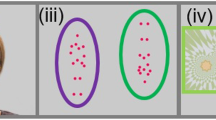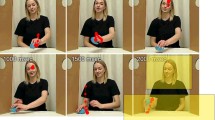Abstract
Variability in attention towards direct gaze and child-directed speech may contribute to heterogeneity of clinical presentation in toddlers with autism spectrum disorders (ASD). To evaluate this hypothesis, we clustered sixty-five 20-month-old toddlers with ASD based on their visual responses to dyadic cues for engagement, identifying three subgroups. Subsequently, we compared social, language, and adaptive functioning of these subgroups at 3 years of age. The cluster displaying limited attention to social scenes in general exhibited poor outcome at 3 years; the cluster displaying good attention to the scene and to the speaker’s mouth was verbal and high functioning at 3 years. Analysis of visual responses to dyadic cues may provide a clinically meaningful approach to identifying early predictors of outcome.






Similar content being viewed by others
References
Bahrick, L. E. (1987). Infant’s intermodal perception of two levels of temporal structure in natural events. Infant Behavior and Development, 10, 387–416.
Bradshaw, J., Shic, F., & Chawarska, K. (2011). Brief report: Face-specific recognition deficits in young children with autism spectrum disorders. Journal of Autism and Developmental Disorders, 41(10), 1429–1435. doi:10.1007/s10803-010-1150-4.
Burnham, D., & Dodd, B. (2004). Auditory-visual speech integration by prelinguistic infants: Perception of an emergent consonant in the McGurk effect. Developmental Psychobiology, 45(4), 204–220.
Cantwell, D., & Rutter, M. (1994). Classification: Conceptual issues and substantive findings. In M. Rutter, E. Taylor, & L. Hersov (Eds.), Chid and adolescent psychiatry: Modern approaches (pp. 2–21). Oxford: Blackwell.
Chawarska, K., Klin, A., Paul, R., Macari, S., & Volkmar, F. (2009). A prospective study of toddlers with ASD: Short-term diagnostic and cognitive outcomes. Journal of Child Psychology and Psychiatry and Allied Disciplines, 50(10), 1235–1245.
Chawarska, K., Klin, A., & Volkmar, F. (2003). Automatic attention cueing through eye movement in 2-year-old children with autism. Child Development, 74(4), 1108–1122.
Chawarska, K., Macari, S., & Shic, F. (2012). Context modulates attention to social scenes in toddlers with autism. Journal of Child Psychology and Psychiatry, 53(8), 903–913. doi:10.1111/j.1469-7610.2012.02538.x.
Chawarska, K., & Shic, F. (2009). Looking but not seeing: Atypical visual scanning and recognition of faces in 2 and 4-year-old children with autism spectrum disorder. Journal of Autism and Developmental Disorders, 39(12), 1663–1672.
Chawarska, K., Volkmar, F., & Klin, A. (2010). Limited attentional bias for faces in toddlers with autism spectrum disorders. Archives of General Psychiatry, 67(2), 178–185.
Cohen, J. (1988). Statistical power analysis for the behavioral sciences. Hillsdale, NJ: Erlbaum-Drucker.
Cook, R. D., & Weisberg, S. (1982). Residuals and influence in regression. London: Chapman and Hall.
Dalton, K. M., Nacewicz, B. M., Johnstone, T., Schaefer, H. S., Gernsbacher, M. A., Goldsmith, H., et al. (2005). Gaze fixation and the neural circuitry of face processing in autism. Nature Neuroscience, 8(4), 519–526.
Duchowski, A. T. (2003). Eye tracking methodology: Theory and practice. New York: Springer.
Efron, B. (1979). Bootstrap methods: Another look at the jackknife. The Annals of Statistics, 7(1), 1–26.
Efron, B., & Tibshirani, R. (1993). An introduction to the bootstrap. London: Chapman and Hall.
Eikeseth, S., Klintwall, L., Jahr, E., & Karlsson, P. (2011). Outcome for children with autism receiving early and intensive behavioral intervention in mainstream preschool and kindergarten settings. Research in Autism Spectrum Disorders, 6(2), 829–835.
Falck-Ytter, T., Gredeback, G., & von Hofsten, C. (2006). Infants predict other people’s action goals. Nature Neuroscience, 9(7), 878–879.
Farroni, T., Csibra, G., Simion, F., & Johnson, M. H. (2002). Eye contact detection in humans from birth. Proceedings of the National Academy of Sciences of the United States of America, 99(14), 9602–9605.
Gotham, K., Pickles, A., & Lord, C. (2009). Standardizing ADOS scores for a measure of severity in autism spectrum disorders. Journal of Autism and Developmental Disorders, 39(5), 693–705. doi:10.1007/s10803-008-0674-3.
Goutte, C., Toft, P., Rostrup, E., Nielsen, F. A., & Hansen, L. K. (1999). On clustering fMRI time series. NeuroImage, 9, 298–310.
Greene, D. J., Colich, N., Iacoboni, M., Zaidel, E., Bookheimer, S. Y., & Dapretto, M. (2011). Atypical neural networks for social orienting in autism spectrum disorders. NeuroImage, 56(1), 354–362.
Greenough, W. T., Black, J. E., & Wallace, C. S. (2002). Experience and brain development. In M. Johnson, Y. Munakata, et al. (Eds.), Brain development and cognition: A reader (pp. 186–216). Malden, MA: Blackwell Publishers.
Guellaï, B., Coulon, M., & Streri, A. (2011). The role of motion and speech in face recognition at birth. Visual Cognition, 19(9), 1212–1233.
Hastie, T., Tibshirani, R., & Friedman, J. (2009). The elements of statistical learning: Data mining, inference, and prediction. New York: Springer.
Howlin, P. (2005). Outcomes in autism spectrum disorders. In F. R. Volkmar, R. Paul, A. Klin, & D. Cohen (Eds.), Handbook of autism and pervasive developmental disorders: Diagnosis, development, neurobiology, and behavior (3rd ed., Vol. 1, pp. 201–220). Hoboken, NJ: John Wiley & Sons Inc.
Hubert, L., & Arabie, P. (1985). Comparing partitions. Journal of Classification, 2(1), 193–218.
Johnson, M. H., Grossmann, T., & Kadosh, K. C. (2009). Mapping functional brain development: Building a social brain through interactive specialization. Developmental Psychology, 45(1), 151–159.
Jones, W., Carr, K., & Klin, A. (2008). Absence of preferential looking to the eyes of approaching adults predicts level of social disability in 2-year-old toddlers with autism spectrum disorder. Archives of General Psychiatry, 65(8), 946–954.
Kisilevsky, B. S., Hains, S. M. J., Brown, C. A., Lee, C. T., Cowperthwaite, B., Stutzman, S. S., et al. (2009). Fetal sensitivity to properties of maternal speech and language. Infant Behavior and Development, 32(1), 59–71. doi:10.1016/j.infbeh.2008.10.002.
Klin, A., Jones, W., Schultz, R., & Volkmar, F. (2003). The enactive mind, or from actions to cognition: Lessons from autism. In U. Frith & E. Hill (Eds.), Autism: Mind and brain (pp. 127–159). New York: Oxford University Press.
Klin, A., Jones, W., Schultz, R., Volkmar, F., & Cohen, D. (2002). Visual fixation patterns during viewing of naturalistic social situations as predictors of social competence in individuals with autism. Archives of General Psychiatry, 59(9), 809–816.
Klin, A., Saulnier, C. A., Sparrow, S. S., Cicchetti, D. V., Volkmar, F. R., & Lord, C. (2007). Social and communication abilities and disabilities in higher functioning individuals with autism spectrum disorders: The Vineland and the ADOS. Journal of Autism and Developmental Disorders, 37(4), 748–759.
Klintwall, L., & Eikeseth, S. (2012). Number and controllability of reinforcers as predictors of individual outcome for children with autism receiving early and intensive behavioral intervention. Research in Autism Spectrum Disorders, 6, 493–499.
Landa, R. J., Holman, K. C., & Garrett-Mayer, E. (2007). Social and communication development in toddlers with early and later diagnosis of autism spectrum disorders. Archives of General Psychiatry, 64(7), 853–864.
Lansing, C. R., & McConkie, G. W. (1999). Attention to facial regions in segmental and prosodic visual speech perception tasks. Journal of Speech, Language, & Hearing Research, 42(3), 526–539.
Lewkowicz, D. J. (2000). The development of intersensory temporal perception: An epigenetic systems/limitations view. Psychological Bulletin, 126, 2281–2308.
Lewkowicz, D. J., & Hansen-Tift, A. M. (2012). Infants deploy selective attention to the mouth of a talking face when learning speech. Proceedings of the National Academy of Sciences, 109(5), 1431–1436. doi:10.1073/pnas.1114783109.
Lord, C., Risi, S., DiLavore, P. S., Shulman, C., Thurm, A., & Pickles, A. (2006). Autism from 2 to 9 years of age. Archives of General Psychiatry, 63(6), 694–701.
Lord, C., Rutter, M., DiLavore, P. C., & Risi, S. (2000). Autism diagnostic observation schedule. Los Angeles, CA: Western Psychological Services.
Lord, C., Rutter, M., DiLavore, P. C., Risi, S., Gotham, K., & Bishop, S. (2012). Autism diagnostic observation scale-2. Torrance, CA: Western Psychological Services.
MathWorks. (2009). MATLAB 7.8 (Release R2009a). Retrieved from http://www.mathworks.com.
Morris, S. B., & DeShon, R. P. (2002). Combining effect size estimates in meta-analysis with repeated measures and independent-groups designs. Psychological Methods, 7, 105–125.
Mullen, E. (1995). Mullen scales of early learning, AGS edition. Circle Pines, MN: American Guidance Serivce, Inc.
Nadig, A. S., Ozonoff, S., Young, G. S., Rozga, A., Sigman, M., & Rogers, S. J. (2007). A prospective study of response to name in infants at risk for autism. Archives of Pediatrics and Adolescent Medicine, 161(4), 378–383.
Norbury, C. F., Brock, J., Cragg, L., Einav, S., Griffiths, H., & Nation, K. (2009). Eye-movement patterns are associated with communicative competence in autistic spectrum disorders. Journal of Child Psychology and Psychiatry, 50(7), 834–842.
Paul, R., Chawarska, K., Fowler, C., Cicchetti, D., & Volkmar, F. (2007). Listen my children and you shall hear: Auditory preferences in toddlers with autism spectrum disorders. Journal of Speech, Language, and Hearing Research, 50(5), 1350–1364.
Perry, A., Cummings, A., Geier, J. D., Freeman, N. L., Hughes, S., Managhan, T., et al. (2011). Predictors of outcome for children receiving intensive behavioral intervention in a large, community-based program. Research in Autism Spectrum Disorders, 5(1), 592–603.
Pierce, K., Conant, D., Hazin, R., Stoner, R., & Desmond, J. (2011). Preference for geometric patterns early in life as a risk factor for autism. Archives of General Psychiatry, 68(1), 101–109.
R Development Core Team. (2011). R: A language and environment for statistical computing. Vienna, Austria: R Foundation for Statistical Computing. Retrieved from http://www.R-project.org.
Sai, F. Z. (2005). The role of the mother’s voice in developing mother’s face preference: Evidence for intermodal perception at birth. Infant & Child Development, 14(1), 29–50.
SAS Institute Inc. (2002–2010). SAS proprietary software 9.3, Cary, NC.
Sherer, M. R., & Schreibman, L. (2005). Individual behavioral profiles and predictors of treatment effectiveness for children with autism. Journal of Consulting and Clinical Psychology, 73(3), 525–538.
Shic, F. (2008). Computational methods for eye-tracking analysis: Applications to autism. Computer science. New Haven, CT: Yale University.
Shic, F., Bradshaw, J., Klin, A., Scassellati, B., & Chawarska, K. (2010). Limited activity monitoring in toddlers with autism spectrum disorder. Brain Research, 1380, 246–254.
Sparrow, S. S., Balla, D. A., & Cicchetti, D. V. (2005). Vineland adaptive behavior scales, (Vineland-II) (2nd ed.). Circle Pines, MN: American Guidance Service.
Teinonen, T., Aslin, R. N., Alku, P., & Csibra, G. (2008). Visual speech contributes to phonetic learning in 6-month-old infants. Cognition, 108(3), 850–855.
Tibshirani, R., Walther, G., & Hastie, T. (2001). Estimating the number of clusters in a dataset via the gap statistic. Journal of the Royal Statistical Society: Series B, 32(2), 411–423.
Tsao, F.-M., Liu, H.-M., & Kuhl, P. K. (2004). Speech perception in infancy predicts language development in the second year of life: A longitudinal study. Child Development, 75(4), 1067–1084.
Vouloumanos, A., Hauser, M. D., Werker, J. F., & Martin, A. (2010). The tuning of human neonates’ preference for speech. Child Development, 81(2), 517–527. doi:10.1111/j.1467-8624.2009.01412.x.
Ward, J. H., Jr. (1963). Hierarchical grouping to optimize an objective function. Journal of the American Statistical Association, 58(301), 236–244.
Young, G. S., Merin, N., Rogers, S. J., & Ozonoff, S. (2009). Gaze behavior and affect at 6 months: Predicting clinical outcomes and language development in typically developing infants and infants at risk for autism. Developmental Science, 12(5), 798–814. doi:10.1111/j.1467-7687.2009.00833.x.
Acknowledgments
The study was supported by the National Alliance for Autism Research Foundation, Autism Speaks Foundation, NICHD ACE Grant P50 MH081756-0, NIMH Grants 1R03MH086732, and R03 MH092618-01A1. We would also like to thank Celine Saulnier, Amanda Steiner, Karyn Bailey, and Rhea Paul for their contribution to the sample characterization as well as Jessica Bradshaw, Mairin Meltvedt, Grace Chen, Marika Coffman, Alexandra Dowd, Eugenia Gisin, and Jessica Reed for assistance in data collection. We wish to express our appreciation to the families and their children for their time and participation.
Author information
Authors and Affiliations
Corresponding author
Rights and permissions
About this article
Cite this article
Campbell, D.J., Shic, F., Macari, S. et al. Gaze Response to Dyadic Bids at 2 Years Related to Outcomes at 3 Years in Autism Spectrum Disorders: A Subtyping Analysis. J Autism Dev Disord 44, 431–442 (2014). https://doi.org/10.1007/s10803-013-1885-9
Published:
Issue Date:
DOI: https://doi.org/10.1007/s10803-013-1885-9




